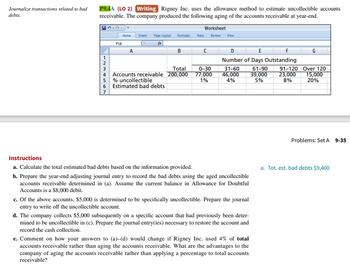Journalize transactions related to bad debts. P9.4A (LO 2) Writing Rigney Inc. uses the allowance method to estimate uncollectible accounts receivable. The company produced the following aging of the accounts receivable at year-end. P18 Home Insert Page Layout Formulas B Total Accounts receivable 200,000 5% uncollectible 6 Estimated bad debts Worksheet Data Review View C 0-30 77,000 1% E Number of Days Outstanding 31-60 61-90 39,000 46,000 4% 5% Instructions a. Calculate the total estimated bad debts based on the information provided. b. Prepare the year-end adjusting journal entry to record the bad debts using the aged uncollectible accounts receivable determined in (a). Assume the current balance in Allowance for Doubtful Accounts is a $8,000 debit. c. Of the above accounts, $5,000 is determined to be specifically uncollectible. Prepare the journal entry to write off the uncollectible account. G 91-120 Over 120 23,000 8% 15,000 20% Problems: Set A 9-35 a. Tot. est. bad debts $9,400
Bad Debts
At the end of the accounting period, a financial statement is prepared by every company, then at that time while preparing the financial statement, the company determines among its total receivable amount how much portion of receivables is collected by the company during that accounting period.
Accounts Receivable
The word “account receivable” means the payment is yet to be made for the work that is already done. Generally, each and every business sells its goods and services either in cash or in credit. So, when the goods are sold on credit account receivable arise which means the company is going to get the payment from its customer to whom the goods are sold on credit. Usually, the credit period may be for a very short period of time and in some rare cases it takes a year.
P9.4

Trending now
This is a popular solution!
Step by step
Solved in 2 steps

parts d and e please









